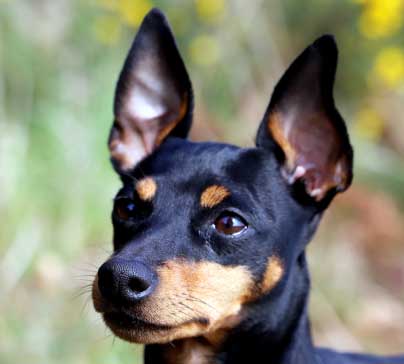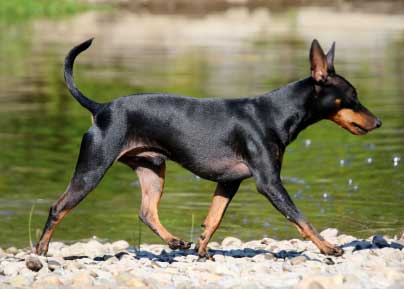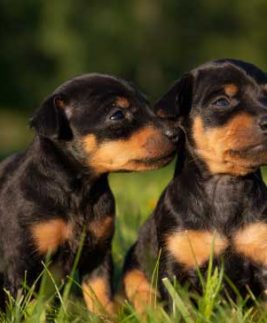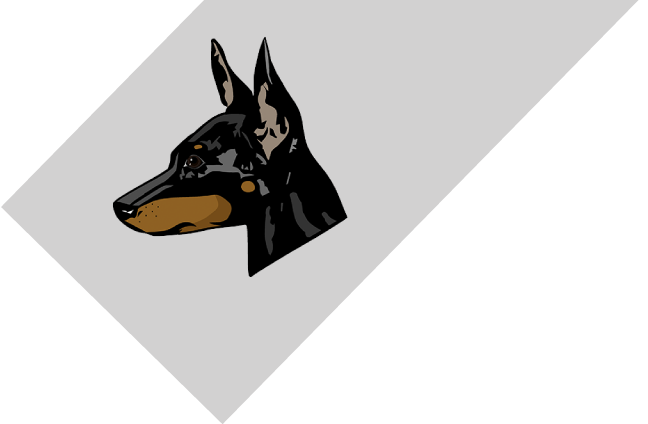Last updated October 2019
Breed Standard
Absolute soundness is essential. Breeders and judges should at all times be careful to avoid obvious conditions or exaggerations which would be detrimental in any way to the health, welfare or soundness of this breed.
From time to time certain conditions or exaggerations may be considered to have the potential to affect dogs in some breeds adversely, and judges and breeders are requested to refer to the Breed Watch section of the Kennel Club website here www.thekennelclub.org.uk watch for details of any such current issues.
If a feature or quality is desirable it should only be present in the right measure. However if a dog possesses a feature, characteristic or colour described as undesirable or highly undesirable it is strongly recommended that it should not be rewarded in the show ring

Head & Skull
Head long, narrow, flat skull, wedge-shaped without emphasis of cheek muscles, well filled up under eyes. Top and bottom jaws held tightly together within compressed lips.
Slight stop. Foreface tapers gently to provide wedge-shaped impression, in profile similar to that seen when viewed from front. Although an illusion of being overshot can result, any suggestion of snipey appearance is undesirable. Nose black.
Ears
Candle-flame shape, slightly pointed tips, placed high upon back of skull and proportionately close together.
A guide to size can be obtained by bending ear forward – it should not reach eye. From nine months of age ear carriage must be erect. Entire inside of ear should face front. Leather of ear thin.


Body
Body compact, head and legs proportionate thus producing correct balance.
Back very slightly curving from behind shoulder to loin, falling again to root of tail. Chest narrow and deep with ribs well sprung. Loins well cut up. Buttocks gently rounded.

Gait Movement
Ideal fore-movement akin to the ‘extended trot’; hackney action not desirable; equally a ‘shuffling gait’ undesirable.
Hind action smooth with ease and precision combined with drive, there should be flowing quality to indicate true soundness.
Colour
Black and Tan. The black ebony, the tan likened to a new chestnut deeply rich. Colours not running or blending into each other, but meeting abruptly, forming clear and well defined lines of colour division.
Forelegs tanned to knees in front. The tan then continuing inside and at back of forelegs to point just below elbows, the thin black line up each toe (pencilling) and a clearly defined black mark (thumb mark) on centre of each pastern, and under chin. Hindlegs well tanned in front and inside with black bar dividing tan at centre of lower thigh. Heavy tan on outside of hindquarters (breeching) undesirable.
Muzzle well tanned. Nose black, the black continuing along top of muzzle, curving below eyes to base of throat. A tan spot above each eye and a small tan spot on each cheek. Under-jaw and throat tanned, lip line black. Hair inside ears tan (tan behind ears undesirable). Each side of chest has some tan. Vent and under root of tail, tan. White hairs forming a patch anywhere totally undesirable.

Faults
Any departure from the foregoing points should be considered a fault.
The seriousness with which the fault should be regarded should be in exact proportion to its degree and its effect upon the health and welfare of the dog and on the dog’s ability to perform its traditional work.
Note for
Prospective puppy buyers

Male animals should have two apparently normal testicles fully descended into the scrotum.

